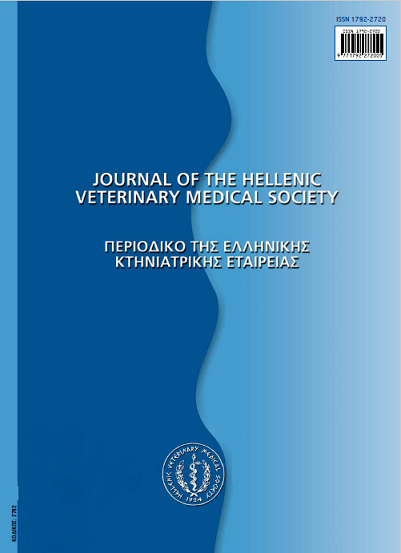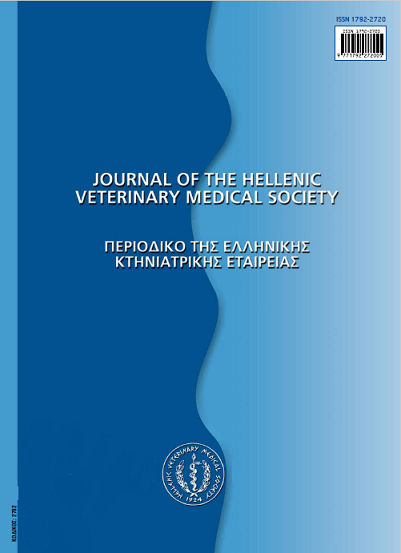Απομόνωση και μοριακός χαρακτηρισμός του γενώματος του ίου Noda σε λαβράκια (Dicentrarchus labrax L.)> που εκτρέφονται σε γλυκό και θαλασσινό νερό στην Ελλάδα

Περίληψη
Σκοπός της παρούσας μελέτης ήταν η απομόνωση του ίου Noda από ιχθυες γλυκού νερού και ειδικά από το είδος Dicentrarchus labrax L. (λαβράκι) και ο μοριακός χαρακτηρισμός του. Σε προηγούμενες μελέτες έχει αναφερθεί η ανίχνευση τουίου Noda με τη μέθοδο της Αλυσιδωτής Αντίδρασης της Πολυμεράσης (ΑΑΠ) σε λαβράκια (Dicentrarchus labrax) που εμφάνιζαν κλινικά συμπτώματα και εκτρέφονταν υπό εντατικές συνθήκες σε γλυκό νερό. Δεν είχε, όμως, επιτευχθεί η απομόνωση του σε κυτταροκαλλιέργεια. Η παρούσα μελέτη περιγράφει την απομόνωση του ίου Noda από ελληνικές εκτροφές λαβρακιου που εμφάνιζαν κλινικά συμπτώματα και που εκτρέφονταν τόσο σε θαλάσσιο όσο και σε γλυκό νερό. Ο ιός απομονώθηκε στην ειδική συνεχή κυτταρική σειρά SSN-1, εκδηλώνοντας χαρακτηριστικό κυτταροπαθογόνο αποτέλεσμα υπό μορφή κενοτοποίωσης και εκφύλισης. Παράλληλα, στο σύνολο των δειγμάτων εγκεφαλικού ιστού και οφθαλμών που προέρχονταν από μολυσμένα λαβράκια, ανιχνεύθηκε, με χρήση της Ανάστροφης Μεταγραφής - της Αλυσιδωτής Αντίδρασης Πολυμεράσης (Reverse Transcription-PCR) και με την τεχνική της nestedRT-PCR (nested Reverse Transcription) - PCR, ένθετη ανάστροφης αντιγραφής- PCR, μια γενωμική περιοχή μεγέθους 255 ζευγών βάσεων (ζβ). Η σύγκριση της αλληλουχίας των νουκλεοτιδίων της παραπάνω περιοχής με αντίστοιχη που ανιχνεύθηκεσε ασθενή λαβράκια ευρωπαϊκής εκτροφής και σε άλλα είδηιχθύων ανέδειξε μεγάλο βαθμό ομολογίας μεταξύ τους.
Λεπτομέρειες άρθρου
- Πώς να δημιουργήσετε Αναφορές
-
XYLOURI (Ε. ΞΥΛΟΥΡΗ) E., KOTZAMANIS (Ι. ΚΟΤΖΑΜΑΝΗΣ) J., ATHANASSOPOULOU (ΑΘΑΝΑΣΟΠΟΥΛΟΥ Φ.) F., DONG, L., ARGYROKASTRITIS (ΑΛ. ΑΡΓΥΡΟΚΑΣΤΡΙΤΗΣ) A., & FRAGKIADAKI (ΕΙΡ. ΦΡΑΓΚΙΑΔΑΚΗ) E. (2017). Απομόνωση και μοριακός χαρακτηρισμός του γενώματος του ίου Noda σε λαβράκια (Dicentrarchus labrax L.)> που εκτρέφονται σε γλυκό και θαλασσινό νερό στην Ελλάδα. Περιοδικό της Ελληνικής Κτηνιατρικής Εταιρείας, 56(2), 105–113. https://doi.org/10.12681/jhvms.15074
- Τεύχος
- Τόμ. 56 Αρ. 2 (2005)
- Ενότητα
- Research Articles
Οι συγγραφείς των άρθρων που δημοσιεύονται στο περιοδικό διατηρούν τα δικαιώματα πνευματικής ιδιοκτησίας επί των άρθρων τους, δίνοντας στο περιοδικό το δικαίωμα της πρώτης δημοσίευσης.
Άρθρα που δημοσιεύονται στο περιοδικό διατίθενται με άδεια Creative Commons 4.0 Non Commercial και σύμφωνα με την άδεια μπορούν να χρησιμοποιούνται ελεύθερα, με αναφορά στο/στη συγγραφέα και στην πρώτη δημοσίευση για μη κερδοσκοπικούς σκοπούς.
Οι συγγραφείς μπορούν να καταθέσουν το άρθρο σε ιδρυματικό ή άλλο αποθετήριο ή/και να το δημοσιεύσουν σε άλλη έκδοση, με υποχρεωτική την αναφορά πρώτης δημοσίευσης στο J Hellenic Vet Med Soc
Οι συγγραφείς ενθαρρύνονται να καταθέσουν σε αποθετήριο ή να δημοσιεύσουν την εργασία τους στο διαδίκτυο πριν ή κατά τη διαδικασία υποβολής και αξιολόγησής της.




